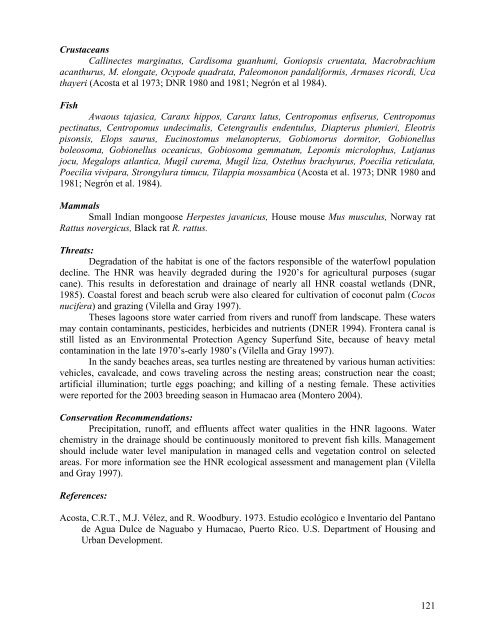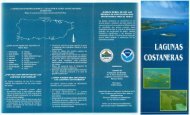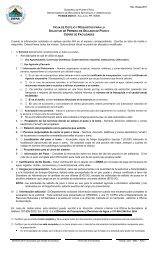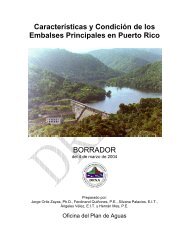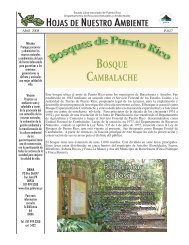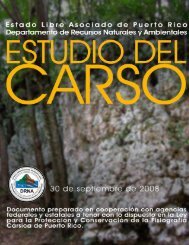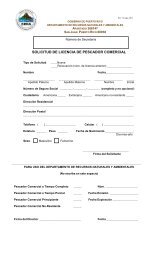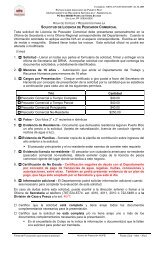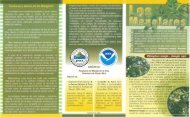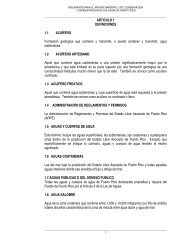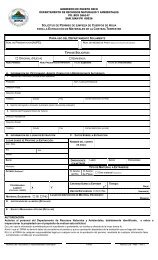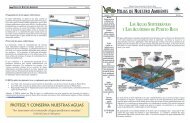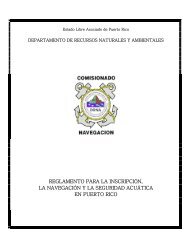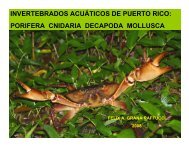uccinator, Black-bellied whistling duck Dendrocygna autumnalis, Common moorhen Gallinula chloropus, Purple gallinule Porphyrula martinica, Pied-billed grebe Podilymbus podiceps, White-crowned pigeon Patagioenas leucocephala, Scaly-napped pigeon P. squamosa, Zenaida dove Zenaida aurita (Cardona and Rivera 1988); Spotted sandpiper Actitis macularia, American black duck Anas rubripes, Antillean Mango Anthracothorax dominicus, Green mango A. viridis, Short-eared owl Asio flammeus, Great blue heron Ar<strong>de</strong>a herodias, Canvasback Aythya valisineria, Canary winged parakeet Brotogeris versicolurus, Cattle egret Bubulcus ibis, Redtailed hawk Buteo jamaicensis, Green heron Butori<strong>de</strong>s virescens, Pectoral sandpiper Calidris melanotos, Common snipe Gallinago gallinago, Great egret Ar<strong>de</strong>a alba, Belted kingfisher Ceryle alcyon, Semipalmated plover Charadrius semipalmatus, Kill<strong>de</strong>er C. vociferus, Wilson’s plover C. wilsonia, Bananaquit Coereba flaveola, Rock pigeon Columba livia, Common ground dove Columbina passerina, Smooth-billed ani Crotophaga ani, Yellow rumped warbler Dendroica coronata, Prairie warbler D. discolor, Yellow warbler D. petechia, Little blue heron Egretta caerulea, Snowy egret E. thula, Tricolored heron E. tricolor, Orange cheeked waxbill Estrilda melpoda, Merlin Falco columbarius, American kestrel F. sparverius, Frigate bird Fregata magnificens, American coot Fulica americana, Common yellowthroat Geothlypis trichas, Black-necked stilt Himantopus mexicanus, Barn swallow Hirundo rustica, Troupial Icterus icterus, Least bittern Ixobrychus exilis, Herring gull Larus argentatus, Laughing gull L. atricilla, Bronze mannikin Lonchura cucullata, Warbling silverbill L. malabarica, Chestnut mannikin L. malacca, <strong>Puerto</strong> Rican Bullfinch Loxigilla portoricensis, Pearly-eyed thrasher Margarops fuscatus, Northern mockingbird Mimus polyglottos, Black and white warbler Mniotilta varia, Shiny cowbird Molothrus bonariensis, <strong>Puerto</strong> Rican Flycatcher Myiarchus antillarum, Black-crowned night heron Nycticorax nycticorax, Yellow-crowned night-heron Nyctanassa violacea, Antillean crested hummingbird Orthorhyncus cristatus, Osprey Pandion haliaetus, Northern parula Parula americana, Cave swallow Petrochelidon fulva, Doublecrested cormorant Phalacrocorax auritus, Glossy ibis Plegadis falcinellus, Black-bellied plover Pluvialis squatarola, Sora Porzana carolina, Purple martin Progne subis, Prothonotary warbler Protonotaria citrea, Greater Antillean Grackle Quiscalus niger, Northern waterthrush Seiurus noveboracensis, American Redstart Setophaga ruticilla, <strong>Puerto</strong> Rican Spindalis Spindalis portoricensis, Royal tern Sterna maxima, Red footed booby Sula sula, Black-faced grassquit Tiaris bicolor, Yellow-faced grassquit T. olivacea, Lesser yellowlegs Tringa flavipes, Greater yellowlegs T. melanoleuca, Solitary sandpiper T. solitaria, Loggerhead kingbird Tyrannus caudifasciatus, Gray kingbird T. dominicensis, Black-whiskered vireo Vireo altiloquus, Pintailed whydah Vidua macroura, Zenaida dove Zenaida aurita (Acosta et al 1973; DNR 1980 and 1981; Negrón et al 1984). Reptiles Sea turtles nest in the sandy beach: Leather back turtle Dermochelys coriacea, Hawksbill turtle Eretmochelys imbricata, Loggerhead sea turtle Caretta caretta, <strong>Puerto</strong> Rican sli<strong>de</strong>r Trachemys stejnegeri. Other reptiles are: <strong>Puerto</strong> Rican ground lizard Ameiva exsul, Crested anole Anolis cristatellus, Common grass anole A. pulchellus, Nichol’s dwarf gecko Sphaerodactylus nicholsi (Aponte et al 1973; DNR 1980 and 1981; Negrón et al 1984). Amphibians Coqui spp. Eleutherodactylus spp., White-lipped frog Leptodactylus albilabris, Giant toad Bufo marinus, Bullfrog Rana catesbeiana. (Acosta et al 1973; DNR 1980 and 1981; Negrón et al 1984). 120
Crustaceans Callinectes marginatus, Cardisoma guanhumi, Goniopsis cruentata, Macrobrachium acanthurus, M. elongate, Ocypo<strong>de</strong> quadrata, Paleomonon pandaliformis, Armases ricordi, Uca thayeri (Acosta et al 1973; DNR 1980 and 1981; Negrón et al 1984). Fish Awaous tajasica, Caranx hippos, Caranx latus, Centropomus enfiserus, Centropomus pectinatus, Centropomus un<strong>de</strong>cimalis, Cetengraulis en<strong>de</strong>ntulus, Diapterus plumieri, Eleotris pisonsis, Elops saurus, Eucinostomus melanopterus, Gobiomorus dormitor, Gobionellus boleosoma, Gobionellus oceanicus, Gobiosoma gemmatum, Lepomis microlophus, Lutjanus jocu, Megalops atlantica, Mugil curema, Mugil liza, Ostethus brachyurus, Poecilia reticulata, Poecilia vivipara, Strongylura timucu, Tilappia mossambica (Acosta et al. 1973; DNR 1980 and 1981; Negrón et al. 1984). Mammals Small Indian mongoose Herpestes javanicus, House mouse Mus musculus, Norway rat Rattus novergicus, Black rat R. rattus. Threats: Degradation of the habitat is one of the factors responsible of the waterfowl population <strong>de</strong>cline. The HNR was heavily <strong>de</strong>gra<strong>de</strong>d during the 1920’s for agricultural purposes (sugar cane). This results in <strong>de</strong>forestation and drainage of nearly all HNR coastal wetlands (DNR, 1985). Coastal forest and beach scrub were also cleared for cultivation of coconut palm (Cocos nucifera) and grazing (Vilella and Gray 1997). Theses lagoons store water carried from rivers and runoff from landscape. These waters may contain contaminants, pestici<strong>de</strong>s, herbici<strong>de</strong>s and nutrients (DNER 1994). Frontera canal is still listed as an Environmental Protection Agency Superfund Site, because of heavy metal contamination in the late 1970’s-early 1980’s (Vilella and Gray 1997). In the sandy beaches areas, sea turtles nesting are threatened by various human activities: vehicles, cavalca<strong>de</strong>, and cows traveling across the nesting areas; construction near the coast; artificial illumination; turtle eggs poaching; and killing of a nesting female. These activities were reported for the 2003 breeding season in Humacao area (Montero 2004). Conservation Recommendations: Precipitation, runoff, and effluents affect water qualities in the HNR lagoons. Water chemistry in the drainage should be continuously monitored to prevent fish kills. Management should inclu<strong>de</strong> water level manipulation in managed cells and vegetation control on selected areas. For more information see the HNR ecological assessment and management plan (Vilella and Gray 1997). References: Acosta, C.R.T., M.J. Vélez, and R. Woodbury. 1973. Estudio ecológico e Inventario <strong>de</strong>l Pantano <strong>de</strong> Agua Dulce <strong>de</strong> Naguabo y Humacao, <strong>Puerto</strong> <strong>Rico</strong>. U.S. Department of Housing and Urban Development. 121
- Page 1 and 2:
Puerto Rico Critical Wildlife Areas
- Page 3 and 4:
19) Larga Beach and Zoní Lagoon, C
- Page 5 and 6:
67) Monito Island ……………
- Page 7 and 8:
Dedicatory We honor to dedicate thi
- Page 9 and 10:
Introduction After twenty years fro
- Page 11 and 12:
Department of Natural and Environme
- Page 13 and 14:
collaris, American Wigeon A. americ
- Page 15:
Villanueva, E., L. J. Rivera-Herrer
- Page 19:
Birds in the Fort Buchanan Pond The
- Page 23 and 24:
designated a Natural Reserve in 197
- Page 25 and 26:
in the waters that enter through th
- Page 29 and 30:
4- Barrio Borinquen, Trujillo Alto
- Page 33 and 34:
5- Baja Swamp and Herrera River Mou
- Page 37 and 38:
6- Ensenada Comezón and Espíritu
- Page 39 and 40:
Echinodermata: Sea Urchin Eucidaris
- Page 43:
7- Río Mar, Street # 968, Río Gra
- Page 47 and 48:
Puerto Rican Lizard cuckoo Saurothe
- Page 51 and 52:
9- San Miguel, Las Paulinas and El
- Page 53 and 54:
From the 18 km. of monitored areas,
- Page 57 and 58:
10- Laguna Grande, Laguna Aguas Pri
- Page 61:
11- Fajardo Coastline, Fajardo, Pue
- Page 65 and 66:
Virgin Islands boa Epicrates monens
- Page 68 and 69:
13- Flamenco Peninsula, Culebra Isl
- Page 70 and 71:
Threats: The development of recreat
- Page 74 and 75:
16- Resaca Mountain, Culebra, Puert
- Page 76 and 77:
Hall, K. V. and A. D. Tucker. 1985.
- Page 78: References: Aponte Pagán, M. 1981.
- Page 82 and 83: The mangroves of Puerto Del Manglar
- Page 84 and 85: 23- Cementerio Bay, Culebra, Puerto
- Page 86: Slippery-backed mabuya Mabuya mabou
- Page 90 and 91: Mammals The seagrass beds in the we
- Page 92 and 93: Birds at Playa Grande Lagoon Forty
- Page 96 and 97: 26- Ensenada Honda Mangrove, Vieque
- Page 100 and 101: 27- Yanuel Lagoon, Vieques Island S
- Page 104 and 105: 28- Chiva Swamp, Vieques Island Sou
- Page 106: References Raffaele, H. A. 1972. Se
- Page 109 and 110: 30- Ferro Bay, Mosquito Bay, and So
- Page 111 and 112: Seliger, H. 2001. Bioluminescence i
- Page 113 and 114: 105
- Page 115 and 116: Conservation Recommendations: Becau
- Page 117 and 118: 109
- Page 119 and 120: squatarola, Whimbrel Numenius phaeo
- Page 121 and 122: 113
- Page 123 and 124: 33- Ceiba State Forest, Fajardo, Ce
- Page 125 and 126: 117
- Page 127: 34- Humacao Natural Reserve, Humaca
- Page 131 and 132: 123
- Page 133 and 134: 35- Pandura Mountain Range, Yabucoa
- Page 135 and 136: Valenciano Project Area, Juncos, Pu
- Page 137 and 138: 129
- Page 139 and 140: Conservation Recommendations: The m
- Page 141 and 142: 133
- Page 143 and 144: Birds Forty eight bird species have
- Page 145 and 146: 137
- Page 147 and 148: 38- Cerro El Gato and Associated Ar
- Page 149 and 150: 141
- Page 151 and 152: 39- Cidra Lake, Cidra, Puerto Rico
- Page 153 and 154: 145
- Page 155 and 156: 40- Aguirre State Forest, Punta Poz
- Page 157 and 158: crowned pigeon Patagioenas leucocep
- Page 159 and 160: Tarpon snook Centropomus pectinatus
- Page 161 and 162: Coastal Resource Management. 1983.
- Page 163 and 164: 155
- Page 165 and 166: D. petechia, Northern Waterthrush S
- Page 167 and 168: 159
- Page 169 and 170: Northern parula Parula americana, B
- Page 171 and 172: 163
- Page 173 and 174: noveboracensis, Royal tern Sterna m
- Page 175 and 176: 167
- Page 177 and 178: Threats: There is a high pressure f
- Page 179 and 180:
171
- Page 181 and 182:
Birds in Berbería Cay Thirteen bir
- Page 183 and 184:
175
- Page 185 and 186:
46- Serrallés Lagoons Complex, Jua
- Page 187 and 188:
179
- Page 189 and 190:
47- Toro Negro State Forest, Ciales
- Page 191 and 192:
Conservation Recommendations: Manag
- Page 193 and 194:
185
- Page 195 and 196:
semipalmatus, Short-billed dowitche
- Page 197 and 198:
189
- Page 199 and 200:
Patagioenas squamosa, Mangrove cuck
- Page 201 and 202:
193
- Page 203 and 204:
50- Punta Verraco, Cerro Toro and P
- Page 205 and 206:
197
- Page 207 and 208:
51- Guayanilla Hills, Guayanilla, P
- Page 209 and 210:
201
- Page 211 and 212:
52- Guánica Lagoon, Guánica-Lajas
- Page 213 and 214:
acuta, Green-winged teal A. crecca,
- Page 215 and 216:
Guánica Lagoon Map obtained from M
- Page 217 and 218:
209
- Page 219 and 220:
Cave swallow Petrochelidon fulva, C
- Page 221 and 222:
213
- Page 223 and 224:
54- San Jacinto Salt Flats and Tama
- Page 225 and 226:
217
- Page 227 and 228:
55- Susúa State Forest and Adjacen
- Page 229 and 230:
221
- Page 231 and 232:
56- La Parguera Natural Reserve, La
- Page 233 and 234:
associated with tourism is destroyi
- Page 235 and 236:
227
- Page 237 and 238:
229
- Page 239 and 240:
ecause of its historic importance f
- Page 241 and 242:
In 1995, the USFWS initiated a chal
- Page 243 and 244:
235
- Page 245 and 246:
58- Boquerón State Forest, Lajas,
- Page 247 and 248:
Fish A study of fish abundance real
- Page 249 and 250:
59- Boquerón Wildlife Refuge, Cabo
- Page 251 and 252:
Antillean Grackle Quiscalus niger,
- Page 253 and 254:
245
- Page 255 and 256:
60- Cabo Rojo Salt Flats and Adjace
- Page 257 and 258:
Conservation Recommendations: Buffe
- Page 259 and 260:
251
- Page 261 and 262:
Greater yellowlegs Tringa melanoleu
- Page 263 and 264:
255
- Page 265 and 266:
62- Joyuda Lagoon Natural Reserve,
- Page 267 and 268:
to the system. Other recommendation
- Page 269 and 270:
261
- Page 271 and 272:
National Oceanic and Atmospheric Ad
- Page 273 and 274:
265
- Page 275 and 276:
sandpiper C. pusilla, Royal tern St
- Page 277 and 278:
SOPI. 2003. Avistamientos en la Ca
- Page 279 and 280:
271
- Page 281 and 282:
Ownership/Protection: The Maricao S
- Page 283 and 284:
_____ and _____. 1990. Lista prelim
- Page 285 and 286:
277
- Page 287 and 288:
Advisory Council on Historic Preser
- Page 289 and 290:
controlling the population. Surroun
- Page 291 and 292:
_____. 1973. Pelagic life zone arou
- Page 293 and 294:
285
- Page 295 and 296:
67- Monito Island, Puerto Rico Area
- Page 297 and 298:
Morales, D. 1985. Documento de Desi
- Page 299 and 300:
291
- Page 301 and 302:
In addition to protecting water qua
- Page 303 and 304:
295
- Page 305 and 306:
Conservation Recommendations: The C
- Page 307 and 308:
299
- Page 309 and 310:
Scaly-naped pigeon Patagioenas squa
- Page 311 and 312:
Meier, A. J.; R.E. Noble, and H.A.
- Page 313 and 314:
71- Barrio Coto, Isabela Area Descr
- Page 315 and 316:
72- Guajataca Cliffs, Isabela-Quebr
- Page 317 and 318:
309
- Page 319 and 320:
311
- Page 321 and 322:
Wildlife: Birds Fifty seven bird sp
- Page 323 and 324:
315
- Page 325 and 326:
74- Guajataca Lake, Isabela-San Seb
- Page 327 and 328:
319
- Page 329 and 330:
75- Barrio Cocos and Bellaca Creek,
- Page 331 and 332:
Santiago Valentín, E. 1995. Reprod
- Page 333 and 334:
325
- Page 335 and 336:
327
- Page 337 and 338:
Amphibians White-lipped frog Leptod
- Page 339 and 340:
331
- Page 341 and 342:
Wildlife: With one hundred and nine
- Page 343 and 344:
springs to manage salinity levels w
- Page 345 and 346:
337
- Page 347 and 348:
339
- Page 349 and 350:
Prairie warbler D. discolor, Ovenbi
- Page 351 and 352:
343
- Page 353 and 354:
345
- Page 355 and 356:
Amphibians Antillean coqui Eleuther
- Page 357 and 358:
80- Hacienda La Esperanza Natural R
- Page 359 and 360:
Threats: Some areas are susceptible
- Page 361 and 362:
353
- Page 363 and 364:
Wildlife: Birds at Tortuguero Lagoo
- Page 365 and 366:
Grana Raffuci, F. A. 2000. Letter t
- Page 367 and 368:
359
- Page 369 and 370:
tanager Spindalis portoricensis, Ye
- Page 371 and 372:
363
- Page 373 and 374:
83- Vega State Forest, Vega Baja-Ve
- Page 375 and 376:
367
- Page 377 and 378:
84- Lakes and Forests of Dorado, Do
- Page 379 and 380:
371
- Page 381 and 382:
85- Mogotes Río Lajas and Nevárez
- Page 383 and 384:
375
- Page 385 and 386:
References: None available 377
- Page 387 and 388:
87- San Pedro Swamp, Toa Baja Area
- Page 389 and 390:
_____.2004. NPL Listing History. EP
- Page 391 and 392:
383


